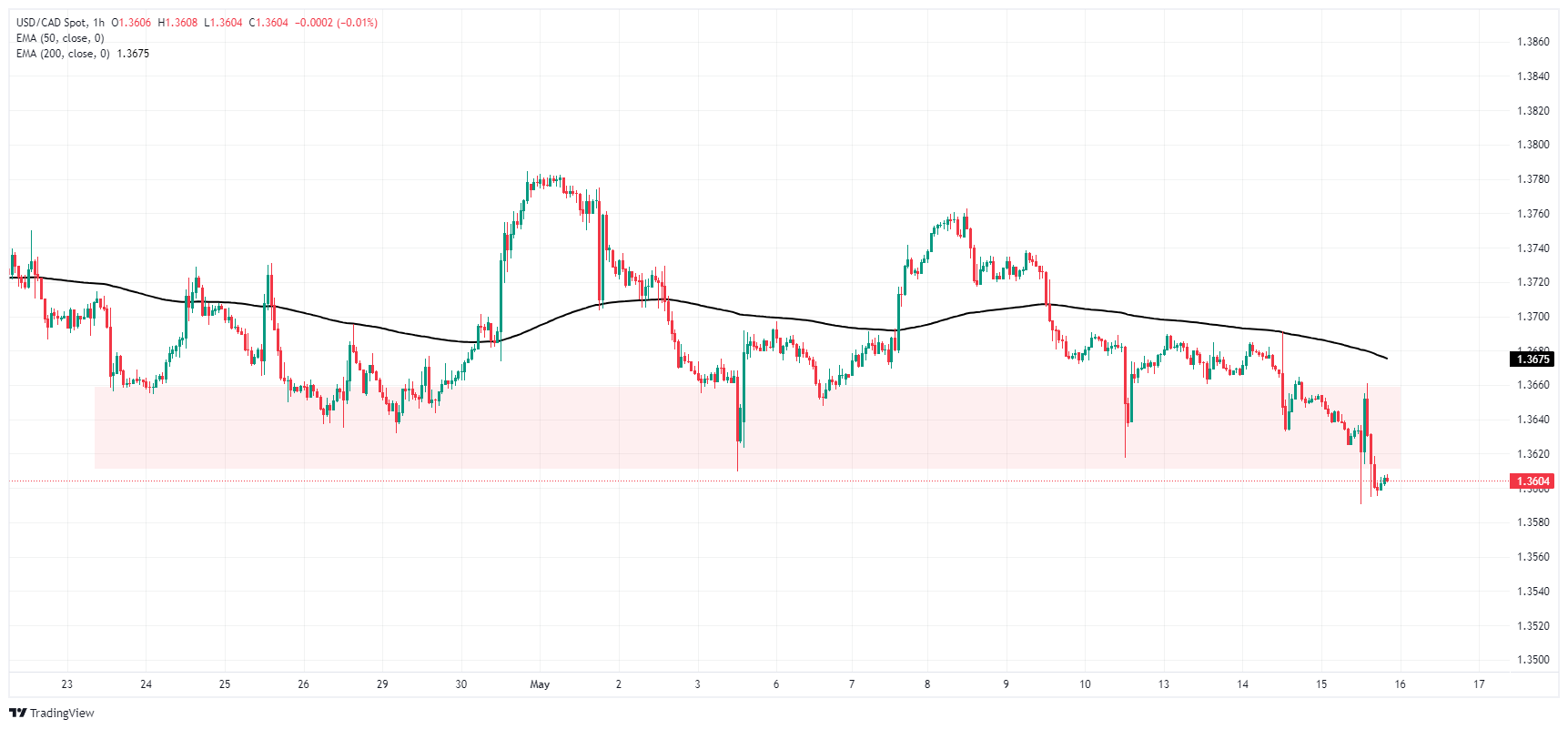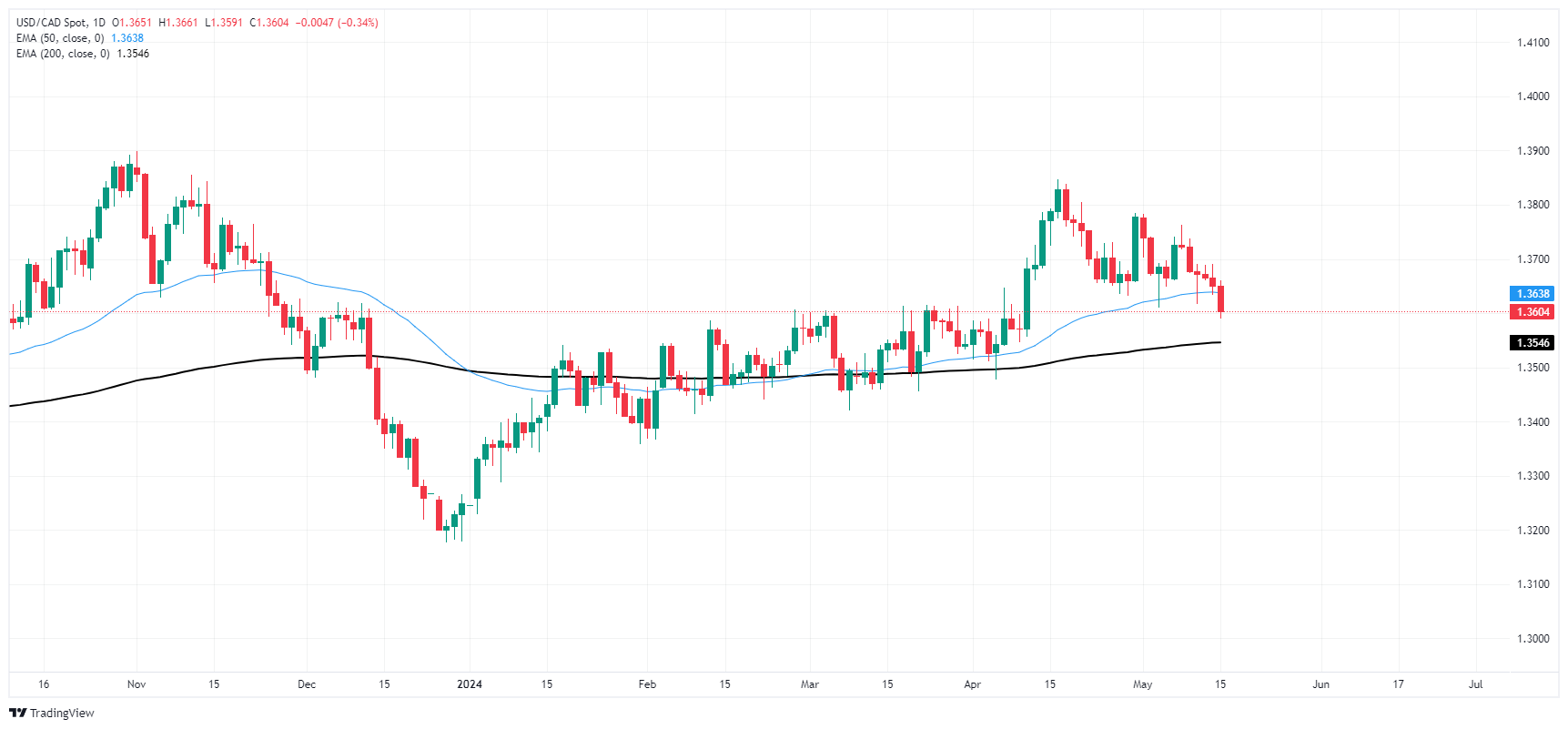- Canadian Dollar weaker on Wednesday but climbs over retreating USD.
- Canada housing and manufacturing figures mixed with little impact.
- Easing US inflation renews September rate cut hopes.
The Canadian Dollar (CAD) weakened on Wednesday as one of the day’s weakest performers, but the CAD will have to settle for second-worst as the US Dollar (USD) broadly retreated following a cooler-than-expected print of US Consumer Price Index (CPI) inflation. Easing inflation pressure is reigniting broad-market hopes for rate cuts from the Federal Reserve (Fed) in September.
Canada saw a slight decrease in the number of Housing Starts for the year through April, though the figure came in higher than expected. Canadian Manufacturing Sales also contracted more than expected in March. Despite misfires, Canadian economic data is strictly low-tier on Wednesday with markets squarely focused on US CPI inflation.
Daily digest market movers: CAD softens on Wednesday, but USD softer
- MoM US CPI inflation in April cooled to 0.3% from the expected hold at 0.4%, reigniting risk appetite and sending Greenback to floorboards.
- Core US CPI inflation for year through April also cooled, printing at the average forecast of 3.6% compared to previous period’s 3.8%.
- Easing inflation pressures are stoking investor hopes for a Fed rate cut in September; according to the CME’s FedWatch Tool, rate markets are pricing in 71% odds of at least a 25-basis-point rate trim.
- US Retail Sales in April also printed below expectations at a flat 0.0%, worse than the forecasted tick down to 0.4% from the previous 0.6% (revised from 0.7%).
- Easing Retail Sales figures add to market hopes for rate cuts as the US economy cools off.
- Canadian Housing Starts for the year ended April by easing to 240.2K, above the forecast for 238K but still back slightly from the previous figure of 242.3K.
- Canadian Manufacturing Sales for March declined -2.1%, worse than expected -1.4%. The previous month’s physical inventory sales were revised slightly higher to 0.9% from 0.7%.
Canadian Dollar PRICE Today
The table below shows the percentage change of Canadian Dollar (CAD) against listed major currencies today. Canadian Dollar was the strongest against the US Dollar.
| USD | EUR | GBP | JPY | CAD | AUD | NZD | CHF | |
|---|---|---|---|---|---|---|---|---|
| USD | -0.57% | -0.68% | -0.95% | -0.33% | -0.93% | -1.26% | -0.43% | |
| EUR | 0.57% | -0.12% | -0.35% | 0.20% | -0.40% | -0.71% | 0.13% | |
| GBP | 0.68% | 0.12% | -0.26% | 0.34% | -0.26% | -0.60% | 0.26% | |
| JPY | 0.95% | 0.35% | 0.26% | 0.60% | 0.02% | -0.31% | 0.53% | |
| CAD | 0.33% | -0.20% | -0.34% | -0.60% | -0.60% | -0.94% | -0.08% | |
| AUD | 0.93% | 0.40% | 0.26% | -0.02% | 0.60% | -0.35% | 0.52% | |
| NZD | 1.26% | 0.71% | 0.60% | 0.31% | 0.94% | 0.35% | 0.87% | |
| CHF | 0.43% | -0.13% | -0.26% | -0.53% | 0.08% | -0.52% | -0.87% |
The heat map shows percentage changes of major currencies against each other. The base currency is picked from the left column, while the quote currency is picked from the top row. For example, if you pick the Canadian Dollar from the left column and move along the horizontal line to the US Dollar, the percentage change displayed in the box will represent CAD (base)/USD (quote).
Technical analysis: Canadian Dollar finds technical barriers limiting gains against Greenback
The Canadian Dollar (CAD) was broadly weaker on Wednesday, shedding weight against all of its major currency peers except for the even weaker US Dollar. The CAD is down six-tenths of one percent against the Japanese Yen (JPY) but up a third of one percent against the Greenback.
USD/CAD tumbled into the low side of a near-term demand zone, testing the 1.3600 handle but unable to develop further bearish legs. Accelerating declines have the pair pinned below the 200-hour Exponential Moving Average (EMA) at 1.3678, and a further move lower could be on the cards if bidders remain uninterested in defending 1.3600 to 1.3620.
Recent losses are beginning to pile up with USD/CAD on pace to close in the red for a sixth consecutive trading day. The pair has broken into the bearish side of the 50-day EMA at 1.3638, and the immediate price floor underneath daily candlesticks sits at the 200-day EMA at 1.3546.
USD/CAD hourly chart
USD/CAD daily chart
Canadian Dollar FAQs
The key factors driving the Canadian Dollar (CAD) are the level of interest rates set by the Bank of Canada (BoC), the price of Oil, Canada’s largest export, the health of its economy, inflation and the Trade Balance, which is the difference between the value of Canada’s exports versus its imports. Other factors include market sentiment – whether investors are taking on more risky assets (risk-on) or seeking safe-havens (risk-off) – with risk-on being CAD-positive. As its largest trading partner, the health of the US economy is also a key factor influencing the Canadian Dollar.
The Bank of Canada (BoC) has a significant influence on the Canadian Dollar by setting the level of interest rates that banks can lend to one another. This influences the level of interest rates for everyone. The main goal of the BoC is to maintain inflation at 1-3% by adjusting interest rates up or down. Relatively higher interest rates tend to be positive for the CAD. The Bank of Canada can also use quantitative easing and tightening to influence credit conditions, with the former CAD-negative and the latter CAD-positive.
The price of Oil is a key factor impacting the value of the Canadian Dollar. Petroleum is Canada’s biggest export, so Oil price tends to have an immediate impact on the CAD value. Generally, if Oil price rises CAD also goes up, as aggregate demand for the currency increases. The opposite is the case if the price of Oil falls. Higher Oil prices also tend to result in a greater likelihood of a positive Trade Balance, which is also supportive of the CAD.
While inflation had always traditionally been thought of as a negative factor for a currency since it lowers the value of money, the opposite has actually been the case in modern times with the relaxation of cross-border capital controls. Higher inflation tends to lead central banks to put up interest rates which attracts more capital inflows from global investors seeking a lucrative place to keep their money. This increases demand for the local currency, which in Canada’s case is the Canadian Dollar.
Macroeconomic data releases gauge the health of the economy and can have an impact on the Canadian Dollar. Indicators such as GDP, Manufacturing and Services PMIs, employment, and consumer sentiment surveys can all influence the direction of the CAD. A strong economy is good for the Canadian Dollar. Not only does it attract more foreign investment but it may encourage the Bank of Canada to put up interest rates, leading to a stronger currency. If economic data is weak, however, the CAD is likely to fall.
- SEO Powered Content & PR Distribution. Get Amplified Today.
- PlatoData.Network Vertical Generative Ai. Empower Yourself. Access Here.
- PlatoAiStream. Web3 Intelligence. Knowledge Amplified. Access Here.
- PlatoESG. Carbon, CleanTech, Energy, Environment, Solar, Waste Management. Access Here.
- PlatoHealth. Biotech and Clinical Trials Intelligence. Access Here.
- Source: https://www.fxstreet.com/news/canadian-dollar-gains-ground-against-softening-greenback-as-us-cpi-inflation-cools-202405151637



